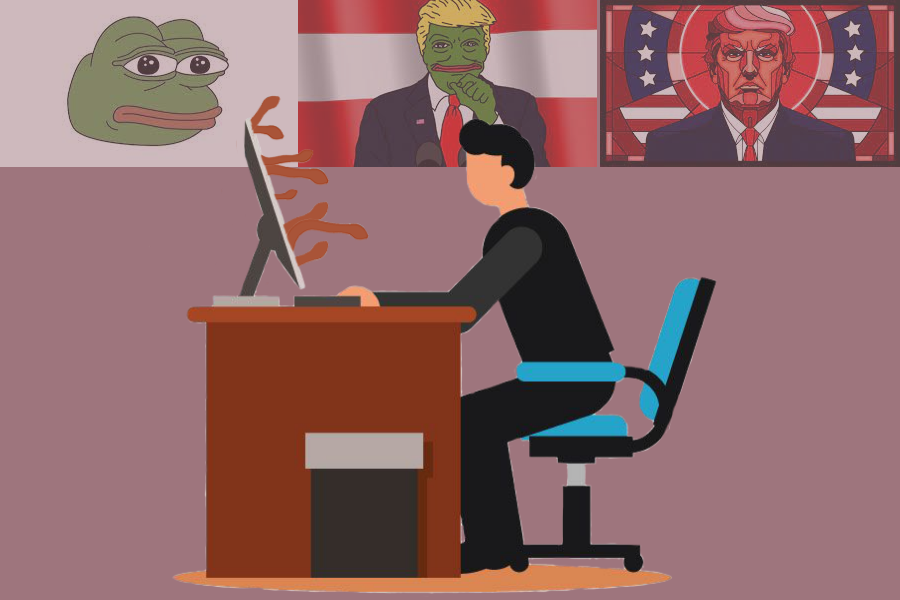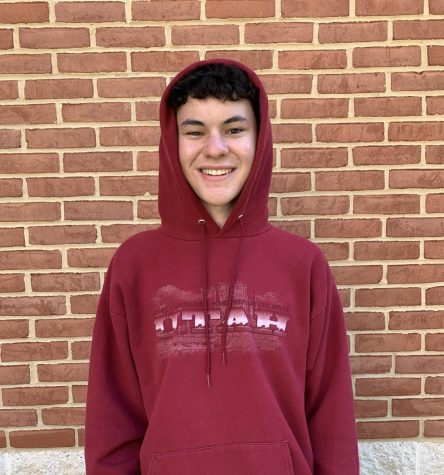Roundtable discussion about alt-right extremism
Hatred has infiltrated online spaces. We’ve gathered specialists to talk about it.
May 14, 2021
In the wake of the January 6 Capitol riots, racially charged killings and widespread conspiracy theories, it has become evident that alt-right terrorism is a prominent domestic threat. Just as concerning is the growing number of teenagers and young adults, some in our own communities, who have been radicalized by online alt-right misinformation.
In response to the issue, The Black & White assembled a panel of experts and academics with experience in the field of far right extremism to discuss the place of alt-right beliefs in American history, the susceptibility of teens to this misinformation and the potential solutions to this ever-growing problem.
Participants: Jessica Acee, a senior fellow at Western States Union, a national civil rights organization, and co-author of the toolkit “Confronting White Nationalism in Schools,” Dr. Gil Noam, developmental psychologist, associate professor at Harvard University and founder of The PEAR Institute (Partnerships in Education and Resilience) which focuses on fostering youth success and development, Dr. Kathryn Olmsted, history professor at the University of California, Davis, who has done extensive work in the field of American anti-government conspiracy theories and Jesse Walker, books editor at Reason magazine and author of “The United States of Paranoia,” a book which details the history of conspiracy theories in American history.
Responses have been edited for length and clarity.
The Black & White: Is there a connection between current Trump-era online conspiracy theories and older conspiracy theories, long-standing prejudice and racism?
Jessica Acee: I don’t think Trump brought or built any hatred or racism — I think he organized and gave space for what already existed. There’s a certain level of empowerment that comes with identifying with the president, and he certainly gave a lot of space and power to these conspiracy theories, racist ideas and xenophobic ideas — but they existed long before Trump became president.
Dr. Kathryn Olmsted: There have been conspiracy theories in this country since before it was a nation. Ever since the first English colonists arrived on North American shores, they brought conspiracy theories with them. These conspiracy theories were about Catholics and Jews, and by the 19th century, about Mormons and racial minority groups. What happened in the 20th century is that increasingly these conspiracy theories are not about race, religion or ethnicity; those still exist, but they’re often being displaced by anti-government conspiracy theories. This trend begins in World War I when the government expands its power dramatically — its size and its surveillance powers.
But really, the modern era of conspiracism begins in the 1960s with the John F. Kennedy assassination. By the 1970s, about 70% of Americans refused to believe the official government report that there was no conspiracy in the President’s assassination; that’s a real turning point. Still though, we didn’t have American presidents spreading these anti-government conspiracy theories. That’s something that is new with Trump. The Trump era is unique and unprecedented in US history because you have a president who is giving credibility to these fringe conspiracy theories, if not overtly endorsing them, sort of winking at them.
Jesse Walker: The more current theories dominating today’s news cycle all draw on previous theories — there’s nothing completely new here. You get new faces, you get new names attached to it, you get new specific allegations and, of course, you get new news events that then get plugged into the previous theories. Pizzagate and Q-Anon — that’s not new. Pizzagate, specifically, is from 2016. Q-Anon began with this person, or group of people, writing as “Q” in late 2017. But theories like those, about having a powerful group of pedophiles who ingest blood, worship Satan and have infiltrated the government — those have been around far longer than the past five years. The most famous versions of these theories, is “the blood libel,” which is the idea — usually aimed at Jews, but sometimes other groups, too — that they met in secret and ingested children. It’s just a very primal story that keeps coming back again and again.
B&W: How has the internet played a role in these conspiracy theories?
Acee: I think social media companies, and to a degree, news and other media companies, have been really irresponsible in the way that they’ve allowed misinformation to proliferate online. There are just outright lies being spoken as truth and it’s hard to discern which is which. We certainly have the capacity and the tools, I think, to make some changes in that area. People spend a lot of time online; information is powerful — images are powerful. Those can all be doctored; videos can be edited in ways that totally obscure the truth. I think especially if we’re talking about young folks, but certainly adults too, none of us really have gotten a good digital literacy education: how to suss out what’s true and what’s real from what’s not, and how to be a digital citizen in 2021. I would really hope that schools would consider offering digital literacy as a required part of programs, especially for high school students.
Dr. Gil Noam: The internet has played a huge role. Online far right communities obviously wouldn’t exist without the internet, but I think as a recruitment tool and as a way to communicate fast, across states and even country boundaries, it is important. The fact that Google, YouTube and Facebook and other methods can be used super fast, even though they’re now trying to really get stricter, until very recently, users could do whatever they wanted. There was a huge effect on the growth of extremist movements.
Walker: I think the internet has changed some things. You can have misinformation that is generated at a much more alarming rate. I don’t think conspiratorial thinking is more common now than before — I think that stories that claim that are really misguided — but I think that there is just a general volume of more theories because they’re being generated quicker, and also being debunked and then forgotten quicker. The other thing about the internet is that it makes it much easier to see what other people are talking about — often with people whom you ordinarily wouldn’t be in contact with. On Facebook or Twitter, you can get this whole window into this set of beliefs that this other group has, who you don’t ordinarily go out and talk with. In the past, you wouldn’t have known that these rumors that seem so alien to you were floating around. Now, you can see it all. Things move more quickly, and there’s a lot more mixing in the internet age, but I don’t think that conspiratorial thinking in general is more common in the internet age. I think that people just don’t realize how much of it has always existed.
B&W: Why are people attracted to these ideas? Why teens in particular?
Acee: Everybody is looking for a sense of belonging and a place to fit in. Young people are no different. It’s a time where there is a lot of feeling around, and a developmentally appropriate time for people to be looking for their own people, learning how to build connections and asking questions like “who am I?” and “who are my friends?” and “where do I fit?” Those are totally appropriate things for teenagers to be doing; those feelings are strong. The world is confusing and it’s hard to understand why things are the way they are, so people look for belonging connections — they’re also looking to make meaning out of the world. These alt-right groups are capitalizing on that because they’re trying to build their own political base. They want to grow their numbers and they see young people as being really fertile recruitment grounds to build the power of their organizations.
Noam: There’s not one pathway into extremism and there’s not one way to think about it, but I think there are some general pointers that we can use. One of them is that in younger adolescence, the need for belonging, group identification and a sense of community becomes really important. I venture to guess that many of those students that end up in those right wing communities and extremist communities end up feeling alienated and isolated in their friendship group, if they have any. Isolation is really a terrible, terrible thing for young adolescents and it goes to the core. If you look into the families, yes, maybe these families are doing really great, but chances are there were some significant issues that these adolescents are having with their families and the families left them too much on their own devices and they don’t have enough adults to communicate with in a more wholesome way. These extremist environments give them a certain purpose and a certain sense of communication. These recruiters, and there is a lot of recruitment going on both individually but also collectively, really understand what these young adolescents need, which is a sense of community.
For older adolescents, the sense of community is still very important, but what’s also important is a sense of ideology. It becomes not just about, “I’m connecting and I’m with people and I have a place,” but also “The world is divided into white and black, facts and interpretations of the facts, and I don’t have to think that much. My worldview gives me a sense of safety and clarity: even if it’s violent, it’s right, and I feel righteous. I feel I have purpose and I feel like I have power.” These are some of the motivations that go into becoming part of these communities.
Olmsted: Conspiracy theorists can work with one another to try and solve a mystery. They look at documents and say, “How can we support the conspirators?” They all work together to read the “Q” drops, or to look at the official documents on the John F. Kennedy assassination. It makes them feel like they are in the know; they are the people who have the real information because they know about the conspiracy and other Americans are deluded.
B&W: How do we help people that have been taken down the alt-right rabbit hole?
Acee: It’s much easier if the people we’re talking about are younger, and it’s much easier if they haven’t gone too far down the rabbit hole. I don’t think anybody is too far gone, so to speak, but sometimes it’s hard to get through to folks. If we’re talking about schools, having librarians who are active in your school, having school counselors who are active and teachers who are looking for signs of radicalization or extremism in the classroom, then being sure to flag potential extremism and fostering conversations with the students or the parents or both.
Research has shown that the best way to prevent the student from feeling disenfranchised in school — and potentially turning towards one of these groups or towards this ideology — is that they have a trusted adult in the school that they can talk to about it. And to that end, asking people questions and getting at their values is the core of any of this work. It’s not about left or right, or progressive or liberal. It’s, “What do you value? Do you value kindness? Okay. We can find some common ground to work on.” Ask them an increasing level of questions to really get at what’s motivating them. “Why is that joke funny? At whose expense is that funny? Do you think that would be hurtful? Who do you think it would be hurtful to? Does that line up with your values?” There are a lot of really good questions, and so sometimes it matters just if we have time to listen and the energy to listen and invest in people.
Noam: That’s really tough. Once in this network, it becomes almost like a way of being. I mean there is no great motivation to actually change; you have your peer group, you have your emotional needs met, you feel like they’re doing what you believe is right. The other people you can go to are doing the wrong thing. So once you are in that it is very tough. There are a couple of pathways out. One is that the groups become so violent and so extremist that they really break the law, and that leads to arrest and incarceration. That’s one pathway out. It could also lead to more radicalization. Another pathway out is just growing older, wanting jobs. A change in perspective: a girlfriend, a boyfriend, thinking about raising a family. All that can contribute over a longer period of time. I think the most direct way is if the parents really understand what’s going on, and if there’s a lot of intra-family communication and concern about this, as non-judgmental as possible. You want to keep the communication open and you also want the adults in the school to know what’s going on. It should become an open discussion rather than the child totally radicalizing in secret. If schools and other school time programs provide a sense of belonging and mentorship, I think that is the best thing. These experiences are those “other places” where a child can get some of these needs met, and they don’t have to be a hateful person who wants to eradicate other people in order to feel like they matter.
B&W: How should we be fighting misinformation?
Acee: I noticed The New York Times did something around the election where they were highlighting stories that were coming out that were based on partial or complete bits of misinformation. They were dissecting them and explaining what was real and what wasn’t. I really think we have to expect and demand that news companies do that all the time; it can’t just be for the election. Schools can do a better job of making sure our students know how to suss out appropriate sources, how to judge source material and how to know where it comes from. A lot of the far-right conspiracy theories we’re seeing now are about this whole distrust of the media, that news companies are out to spew lies to you and trick you into thinking one thing is true and it’s not. It’s really important, now more than ever, to be conscious of what’s real. There are still real things. There are still facts.











